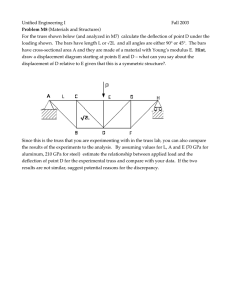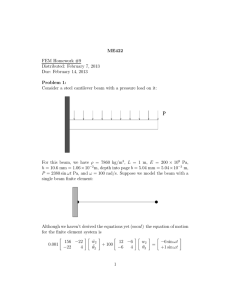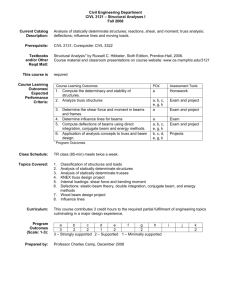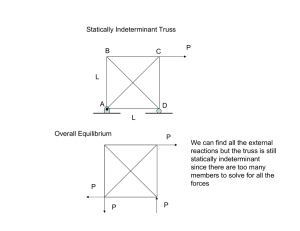1.050: Beam Torsion & 1-D Elasticity (HW#8) Fall 2007
advertisement
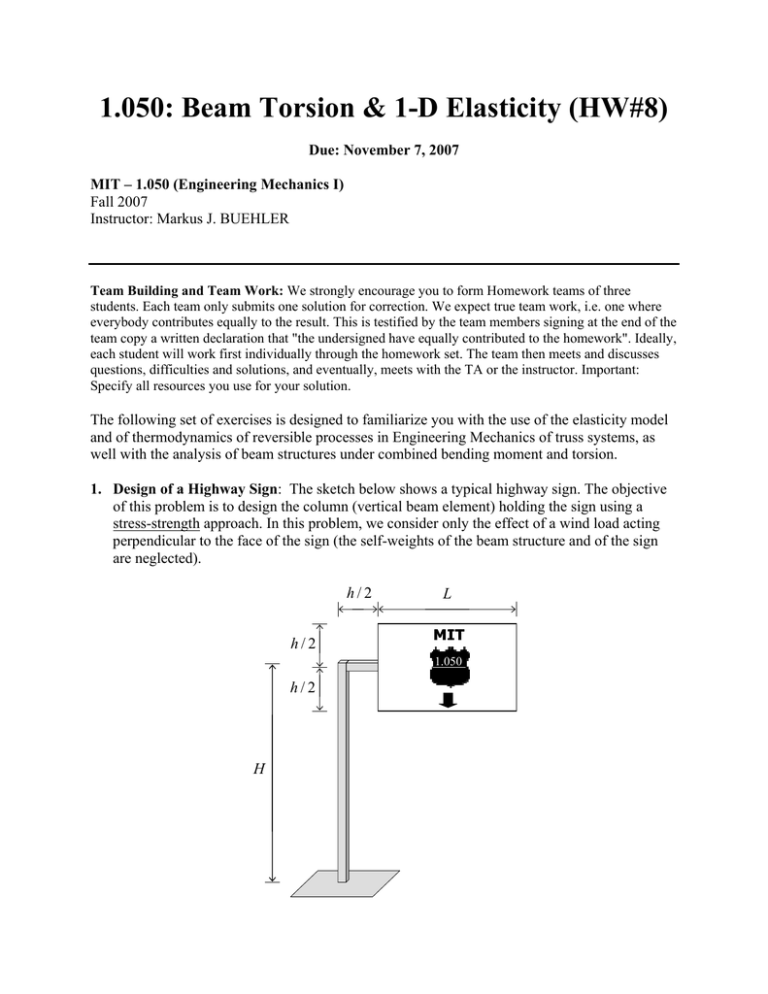
1.050: Beam Torsion & 1-D Elasticity (HW#8) Due: November 7, 2007 MIT – 1.050 (Engineering Mechanics I) Fall 2007 Instructor: Markus J. BUEHLER Team Building and Team Work: We strongly encourage you to form Homework teams of three students. Each team only submits one solution for correction. We expect true team work, i.e. one where everybody contributes equally to the result. This is testified by the team members signing at the end of the team copy a written declaration that "the undersigned have equally contributed to the homework". Ideally, each student will work first individually through the homework set. The team then meets and discusses questions, difficulties and solutions, and eventually, meets with the TA or the instructor. Important: Specify all resources you use for your solution. The following set of exercises is designed to familiarize you with the use of the elasticity model and of thermodynamics of reversible processes in Engineering Mechanics of truss systems, as well with the analysis of beam structures under combined bending moment and torsion. 1. Design of a Highway Sign: The sketch below shows a typical highway sign. The objective of this problem is to design the column (vertical beam element) holding the sign using a stress-strength approach. In this problem, we consider only the effect of a wind load acting perpendicular to the face of the sign (the self-weights of the beam structure and of the sign are neglected). h/2 h/2 L MIT 1.050 h/2 H Due: Wednesday – November 7, 2007 (In class) Page 2 of 4 a. Determine the distribution of the section quantities: normal force, shear force, bending moment and torsion moment for the column. Display quantitatively the results for all section quantities in the form of force and moment diagrams. b. Design the cross-section of the column using a strength criterion given a design wind pressure, p . The beam section is a hollow square, whose dimensions are displayed on the sketch below. The thickness of the wall of the beam is very small with regard to the width of the beam, i.e. t << b . The beam is made of a material whose stress is governed by a Tresca strength criterion with uniaxial strength σ 0 . b b t For this part of the exercise follow these design steps: i. Find the maximum bending capacity of the beam M 0b . ii. Find the maximum torsion capacity of the beam M 0t (Hint: Consider the stress field displayed on the picture below). Figure by MIT OpenCourseWare. iii. What is the bending moment - torsion moment strength capacity of the section? (Neglect any possible effect of shear forces on the strength capacity. The effect of axial forces due to the self-weight of the structure has been neglected in the analysis of this problem). iv. By considering the mixed bending moment - torsion moment strength criterion for the beam, calculate, as a function of σ 0 , what is the maximum wind pressure p that can be applied to the beam? Due: Wednesday – November 7, 2007 (In class) Page 3 of 4 2. 2-D Truss Structure / Another punching bag problem: The sketch below shows a 2-D two-member truss system fixed against a wall and holding a punching bag of weight P at point A . L B A P H C The members are made of the same material and have the same cross-section area S . The constitutive behavior of each truss member is linear elastic, defined by a constitutive relation of the classical Hooke form: FS = K S δ where δ is the change of length of the truss member, and K S = ES / l , where E is the Young's modulus of the material, S the cross-section area, and l the truss member length (which is different for the different truss members (see sketch), meaning that the two truss members have different K S ). a. Error during assembly: During the assembly of the truss system, the inclined truss member AC was built in too long, having a length L2 + H 2 (1 + η ) instead of L2 + H 2 (Note that η << 1 ). In the absence of any applied force (i.e. no punching bag hanging from the truss structure), determine the member forces and the displacement at point A due to the error η in the assembly. b. Consider now that the structure was built without assembly errors. i. Application of Hooke's Law: For the given truss system, determine the member forces and the displacement at point A due to the weight of the punching bag. Due: Wednesday – November 7, 2007 (In class) Page 4 of 4 ii. Show that the result you obtain in Part (i) can be equally obtained by the application of the Thermodynamics of Reversible Processes (see Lecture Notes). In particular, specify: - The external work rate, δW . - The free energy variation, dΨ . - Make use of the zero-dissipation condition, dD = 0 . c. Turning an error into a strength: Determine the value of η so that the elastic vertical displacement at the point of load application is zero. Use the principle of superposition for the results obtained in Parts (a) and (b).



